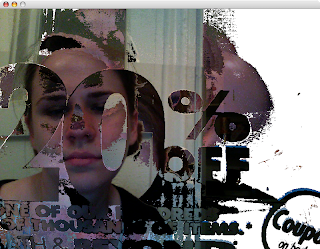Judith notes an important distinction in the "Everyday Interactions" paper regarding technology as an "agent or medum". The metaphors and expectations attached to these roles fundamentally change the way we interact with the system. If the computer acts as a facilitator between people it has a much higher chance of being adopted as a real "everyday" mode of interaction. The system as autonomous is magical, but it's novelty quickly dissipates when it is understood, and further interactions simply reveal the algorithms behind it's behavior.
How can we integrate computational systems to more meaningful, human systems in an inherently more personal (but not intrusive) way? What are these channels and systems of meaning? A few that come to mind are writing, touch, gesture, speaking, the making and exchange of objects, and social traditions of interaction such as eating, theatre, concerts, parties. I want to start experimenting in the domain of large social gatherings, without asking people to alter their activities in any way during the meetings, but augmenting the experience and providing a simple architecture for preparation and follow-up after the social gathering.
Guidelines based on the readings I considered in designing the system are:
A) Balancing the public and private aspects of the interaction. Perhaps one approach to this is to separate the actual data exchanged in the interaction from visual response of the system - by abstracting the data and translating it's form.
B) Not interrupting the natural social flow, or introducing new ways of interacting. Use our existing social framework as an informant for behavioral interaction.
C) Augmenting and rewarding behavior that is social - results in an exchange between two people. Handshakes, Proximity, Time, and Contact information exchanges are all forms which indicate the investment and intimacy of the exchange.
D) Focusing on reviewing data as a private activity - your profile (pre-meeting) and social visualization (post-meeting) as records for you to use as follow up tools. Focus on strengthening the "Broader Social Sphere" - as noted in the cell phone reading.
------------
ourSpace, myRing, myCard, mySocialMap - simple, seamless tools for tracking and augmenting interaction.myRing is a small battery powered circuit with a Bluetooth radio and an RFID proximity sensor. When you come to the meeting you pickup a ring at the door by scanning one of your myCards. myRings are activated by handshakes (proximity) - and also report position data through triangulation by bluetooth receivers. I'm not the first person to think of this form for blue-tooth device, see: http://www.bluepoly.com

myCards are aprox 100 Disposable business cards (contact cards) with simple RFID tags imprinted in the card. Printed from your "web profile" and available at checkin, they serve as a tangible means of exchanging more detailed an intimate information.

These exchanges are measures of proximity and interest - and coupled with proximity sensing - they could act as triggers for pulses of animation and liveliness within a space.

ourSpace is a series of responsive projections in the periphery of the social meeting. Each time a business card is exchanged, or people shake hands, the walls come alive - Plants growing, fish swimming, an entire ecosystem is activated and responds to the activity and history of the space. The visualization is abstract, and immediate - a positive and fun reinforcement of the physical activity in the space, without revealing the identity of the viewer.
Below is a simple view of 3 possible types of projection in a space. (I would use one theme, but I tried plants, snowflakes, fish as examples)

mySocialWeb is a visual record of the night. It includes nodes for each person I shook hands with and more detailed information for people I exchanged business cards with. Business cards can be scanned at home for digital replicas, and links to public web information from the person whom you just met. mySocialWeb is a private web service to help facilitate social relations by allowing for quick follow-up and longterm records of social encounters at a conference, festival, party, art opening, dating function, or business meeting. It is intended for an Urban setting where exchanges are often not repeated and reinforced unless contact information is exchanged at the time of meeting. (in a small town setting such an interface would be intrusive and unnecessary)


















